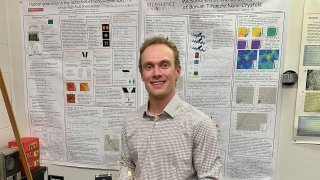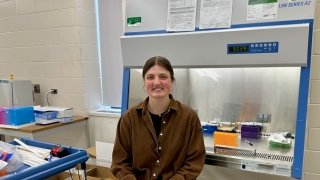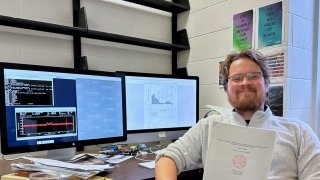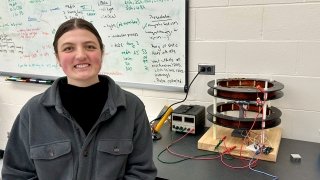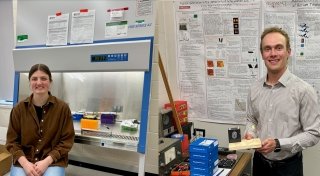
Senior Research Projects 2023 - 2024
Seniors present to the physics department the results of their Phys 489/490: SYE Advanced Laboratory and Phys 499: Honors SYE research projects at the end of each semester. The abstracts for their research are below and photos of the student presenters follow afterwards:
Spring 2024
Construction and Testing of an Electromagnetic Coilgun - Logan Ritchie '24
Conservation of energy has been and will continue to be a backbone in physics. The idea states that in an isolated system, energy cannot be created nor destroyed; the only way the energy of the system can change is through energy flowing into or out of the system. Efficiency is the measure of how well a system converts energy over time. In an ideal world, efficiency will be 100%, but some energy in a system will be considered lost as it is converted into other forms of energy such as heat. The goal of my research is to determine the energy efficiency of a coilgun.
For more information, contact Dr. Catherine Jahncke
Influence of Static Magnetic Field Orientation on HT22 Neural Cell Behavior - Nora Wagner '24
This study investigated the influence of static magnetic field (SMF) exposure on cellular proliferation. We observed a consistent trend where a 30-minute downward vertical SMF exposure significantly increased proliferation compared to other orientations and controls in two different cell lines. This effect remained consistent across variations in exposure time, substrate, media, and cell type. To explore potential mechanisms, we examined reactive oxygen species (ROS) and intracellular calcium levels. While preliminary data suggests a correlation between ROS and proliferation, further studies are needed for confirmation. The observed trends in calcium necessitate further investigation as well.
For more information, contact Dr. Massooma Pirbhai or Dr. Anna Estevez
Fall 2023
Adapting ‘A Generalist, Automated ALFALFA Baryonic Tully-Fisher Relation’ for use with Green Bank Telescope Observational Data - Tyler Karasinski '24
The Baryonic Tully-Fisher Relation (BTFR) describes a proportional relationship between the stellar and neutral hydrogen (HI) mass of a galaxy and its rotational velocity. Since 2021, the Undergraduate ALFALFA Team (UAT) has been working to derive a minimal scatter BTFR with our observing project, GBT 22A – 430: The Baryonic Tully-Fisher Relation for Galaxies with Supernova Distances, as a properly constructed BTFR provides refined estimations of parameters such as mass, rotational velocity, and, indirectly, galaxy distance, by applying the BTFR to a large sample size. In a similar timeframe, Ball et al. 2023, A Generalist, Automated ALFALFA Baryonic Tully-Fisher Relation, has presented a complete, Python-based, automated method of constructing the BTFR for use with Arecibo Legacy Fast ALFA Survey (ALFALFA) galaxies, and with the additional potential to be adapted for use with other large, HI-rich galaxy samples in the local universe. This project aims to adapt Ball et al. 2023’s analysis methodology for use with the 220-galaxy large sample observed by GBT 22A – 430, utilizing GBTIDL, a Green Bank proprietary IDL-based data reduction software, and UAT-developed, pyAPPSS, a Python-based data reduction script for use with Arecibo Pisces-Perseus Supercluster Survey (APPSS) galaxies.
For more information, contact Dr. Aileen O'Donoghue
Influence of Static Magnetic Field Orientation on HT22 Neural Cell Behavior - Nora Wagner '24
Magnetotherapy has the capacity to become a valuable tool in the biomedical field due to its minimally invasive therapeutic potential. Nevertheless, there are numerous unresolved questions surrounding the effects of static magnetic fields (SMFs) on neural cell structure and growth. In our study, we investigate the effects of manipulating the orientation of a 1mT SMF on HT22 neural cells. Our research endeavors to evaluate the influence of factors such as the duration of exposure and orientation of the magnetic field (MF) on proliferation and migration of the cells. By delving into these interactions, we strive to provide insights that contribute to a more comprehensive understanding of magnetotherapy’s potential role in the field of neural biology.
For more information, contact Dr. Massooma Pirbhai or Dr. Anna Estevez

